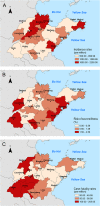Epidemiological characteristics of hand, foot, and mouth disease in Shandong, China, 2009-2016
- PMID: 28827733
- PMCID: PMC5567189
- DOI: 10.1038/s41598-017-09196-z
Epidemiological characteristics of hand, foot, and mouth disease in Shandong, China, 2009-2016
Abstract
In the past decade, hand, foot, and mouth disease (HFMD) has posed a serious threat to childhood health in China; however, no epidemiological data from large HFMD epidemics have been described since 2013. In the present study, we described the epidemiological patterns of HFMD in Shandong province during 2009-2016 from a large number of symptomatic cases (n = 839,483), including >370,000 HFMD cases since 2013. Our results revealed that HFMD activity has remained at a high level and continued to cause annual epidemics in Shandong province from 2013 onwards. Although the incidence rate was significantly higher in urban areas than in rural areas, no significantly higher case-severity and case-fatality rates were found in urban areas. Furthermore, the seventeen cities of Shandong province could be classified into three distinct epidemiological groups according to the different peak times from southwest (inland) to northeast (coastal) regions. Notably, a replacement of the predominant HFMD circulating agent was seen and non-EVA71/Coxsackievirus A16 enteroviruses became dominant in 2013 and 2015, causing approximately 30% of the severe cases. Our study sheds light on the latest epidemiological characteristics of HFMD in Shandong province and should prove helpful for the prevention and control of the disease in Shandong and elsewhere.
Conflict of interest statement
The authors declare that they have no competing interests.
Figures




References
Publication types
MeSH terms
LinkOut - more resources
Full Text Sources
Other Literature Sources
Miscellaneous

